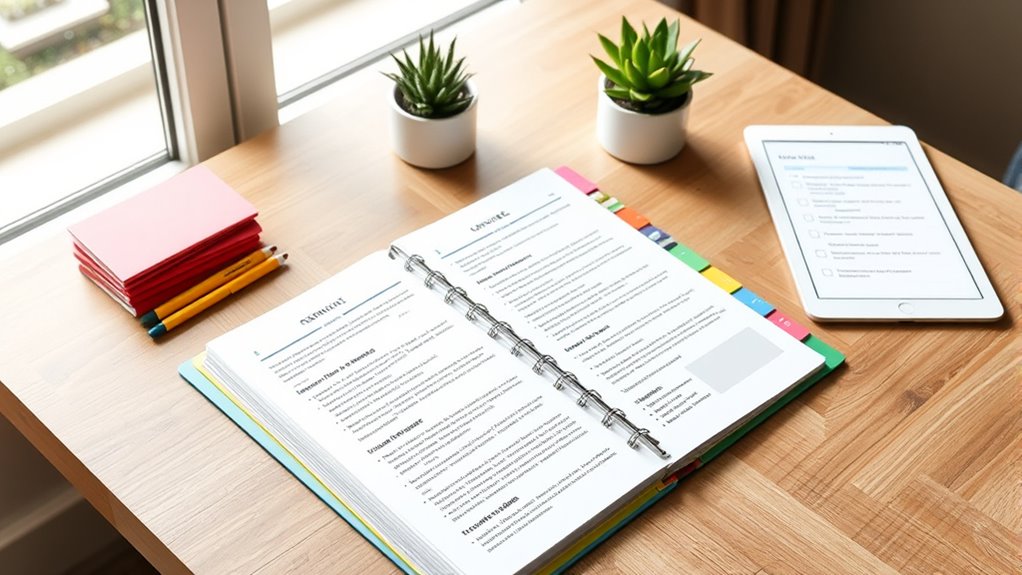To create a care binder that works, organize it with clear labeled sections for medical history, medications, test results, and appointments. Use consistent layouts and tabs for easy reference, updating regularly to reflect changes. Include space for questions and notes for your healthcare visits. Keep copies of important documents accessible and protect your privacy. If you want to learn more about building an effective binder, there are additional tips that can help you stay organized and proactive.
Key Takeaways
- Categorize sections such as medical history, medications, and appointments for quick access.
- Use labeled tabs and consistent layouts to enhance organization and ease of navigation.
- Regularly update the binder to reflect changes in treatments, medications, and health status.
- Include a dedicated space for questions, reminders, and upcoming appointments to stay proactive.
- Protect sensitive information by understanding privacy policies and utilizing secure storage options.

A well-organized care binder can be a game-changer when managing health information and appointments. It serves as your central hub for everything related to your health, making it easier to stay on top of your care plan and communicate effectively with healthcare providers. To get started, focus on creating a system that’s easy to update and navigate. Organization tips like using labeled tabs, clear categories, and a consistent layout can make a big difference. For example, dedicate sections for medical history, medications, test results, appointment reminders, and questions for your doctor. This way, when you need to reference information quickly, you won’t waste time digging through clutter.
A well-organized care binder helps you stay on top of health info and appointments effortlessly.
When developing your care plan section, include a summary of your current treatments, allergies, and key health goals. Keep your care plan concise but thorough; it should act as a quick reference for both you and any healthcare professional involved in your care. To stay organized, use a table or bullet points for easy reading, and update this section regularly to reflect any changes in your treatment or medications. Incorporating organization tips like date-stamping each update helps you track your progress over time and ensures your care plan remains accurate.
Your medication section should list all prescribed drugs, dosages, and refill dates. Use a consistent format for each entry so you can quickly find what you need. Keep a list of over-the-counter medicines, supplements, and any allergies or adverse reactions. Including a section for test results and reports ensures you have access to your health data without needing to request copies from multiple providers. Store copies of recent lab results, imaging reports, and specialist notes in this part of your binder.
Appointment reminders and a calendar section are essential for staying on schedule. Use a dedicated space to jot down upcoming appointments, procedures, and follow-up visits. Adding notes about questions or concerns to discuss can make your visits more productive. To keep everything streamlined, consider using color-coded or highlighter markers for different types of appointments. When you’re prepared and organized, it becomes easier to manage your health proactively rather than reactively.
Regularly review and update your care binder to reflect any changes in your health or treatment plan. This ongoing maintenance ensures your binder remains a reliable resource and reduces the chances of missing important information. Also, understanding the role of privacy policies and cookie management can help you protect your sensitive health data while using online health tools. By following these organization tips and maintaining a detailed, well-structured care plan within your binder, you empower yourself to take control of your health journey. It’s a simple yet powerful tool that helps you stay informed, prepared, and confident in managing your care.
Frequently Asked Questions
How Often Should I Update My Care Binder?
You should update your care binder regularly, ideally on a monthly or quarterly basis, to make certain it stays current. Establish a consistent updating schedule as part of your care binder maintenance, so you don’t forget important information or miss changes. Review and revise details like appointments, medications, and emergency contacts during these updates. Staying proactive helps keep your care binder reliable and useful whenever you need it most.
What Should I Include for Emergency Contacts?
You should include emergency contacts like family, friends, your primary care doctor, and local emergency services. Make certain to add their names, phone numbers, and relationship to you. Also, include your medical history and allergy information so responders know your health background quickly. Keep this section updated with any changes, and guarantee it’s easily accessible in your care binder for quick reference during emergencies.
How Do I Organize Medications Effectively?
Did you know that 65% of medication errors happen due to poor organization? To organize your medications effectively, create a dedicated section for medication schedules and dosage instructions. Use clear labels, separate pills by time of day, and include refill dates. Keep a list of side effects and special instructions. This way, you guarantee safety, ease of use, and quick access when needed, reducing errors and improving your care routine.
Can I Include Digital Copies in My Binder?
Yes, you can include digital copies in your care binder. Use digital backups stored securely on cloud storage services, making it easy to access important documents anytime. Incorporate scanned copies of prescriptions, insurance cards, and medical history, and keep the digital version updated regularly. This way, you have a reliable backup, and your care binder stays organized and accessible both physically and digitally in case of emergencies.
How Do I Ensure Privacy and Security?
Imagine finding a forgotten letter tucked inside your care binder—your digital copies deserve the same protection. You guarantee privacy and security by using strong digital security measures like encryption and secure passwords. Follow privacy protocols such as limiting access to sensitive info and regularly updating your software. This way, your digital copies stay safe, and your personal information remains private, giving you peace of mind every time you access your care binder.
Conclusion
Think of your care binder as a sturdy compass guiding you through life’s storms. With every page, you’re charting a course toward clarity and peace of mind. When chaos tries to drown you out, your binder becomes the lighthouse, shining a steady beam. Keep it organized, keep it close, and let it be your trusted navigator. In this tiny book lies your greatest hope—turning chaos into calm, one page at a time.








